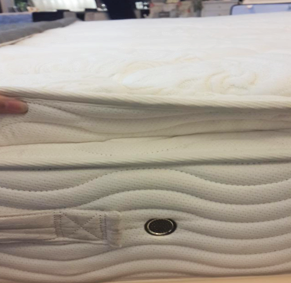What is mattress ticking?
What is mattress ticking fabric?
 Mattress Ticking is the final, outer fabric covering on a mattress. So mattress ticking is the fabric that holds a mattress together.
Mattress Ticking is the final, outer fabric covering on a mattress. So mattress ticking is the fabric that holds a mattress together.
Mattress Ticking is the protective fabric cover used to encase mattresses and foundations. It is usually designed to coordinate with the foundation border fabric and comes in a wide variety of colors and styles. Mattress fabrics can be knits, damask or printed wovens, or inexpensive nonwovens. During the past decade, along with the rise in popularity of all-foam beds, stretchy knit ticking on the bed's top panel has become a standard look on both innerspring and foam beds. Most ticking is made with polyester yarns. More expensive mattress fabrics may contain a combination of polyester with rayon, cotton, silk, wool or other natural yarns.[9]
Until the early 2000s, beds were normally upholstered with a single fabric. This was usually a damask ticking or, for inexpensive bedsets, a nonwoven fabric covering all surfaces of the mattress and foundation. Today's bedsets are covered with up to six different fabrics: A better quality circular knit or woven damask on the top panel—the bed's sleeping surface; a matching or contrasting [usually woven] fabric on the border of the mattress; a matching or contrasting [usually woven] fabric on the foundation side panels; a 'non-skid' woven or non-woven fabric on the surface of the foundation and reverse side of the mattress; and a nonwoven dust cover on the under side of the foundation. Some North American mattress producers are beginning to use furniture upholstery fabrics on the bed's borders giving beds a more European, home furnishings look.[10]
(the above is defined in https://en.wikipedia.org/wiki/Ticking)
Requirements of Mattress Ticking
While most people think that ticking is the appearance of the mattress, it actually has to meet several requirements. It’s also an important component to the mattress that you’ll purchase.
Material
The ticking has to be made of quality material so it will last for several years. mattress ticking is made from polyester or polypropylene, and can be made from cotton or viscose. The following is referred by lindsay pietroluongo’s article.
Resistance
Mattress ticking must by hygienic and stain-resistance. It should also help reduce air pollutants.
Requirements
Mattress developers must make their ticking hypoallergenic, anti-dust mite, breathable, anti-static and water resistant.
Details
When choosing a mattress, focus more on just the visual appeal. The ticking may have a quilted finish or hand stitching. These details will help the mattress retain its shape.
Safety
Check if the mattress has passed the BS7177 or CFR 1633 test, which tests for flammability.
What is ticking?
Ticking is a cotton or linen textile that is tightly woven for durability and to prevent down feathers from poking through the fabric,[1] and used to cover mattresses and bed pillows.[2] It commonly has a striped design, in muted colors such as brown, grey or blue, and occasionally red or yellow, against a plain, neutral background.
Although traditionally used for mattresses and pillows, the material has found other uses, such as serving as a backing for quilts, coverlets, and other bedding.[1] It is sometimes woven with a twill weave.
Ticking is no longer restricted to a utility fabric and has found uses in interior decorating styles intending to evoke a homespun or industrial aesthetic. Modern uses for ticking include furniture upholstery, cushion covers, tablecloths, decorative basket liners, and curtains. Occasionally, lighter weight percale cloth is printed with a striped pattern made to resemble ticking fabric, and used to make garments. (From wikipedia.org)
What is pillow ticking?

The outside cover on a pillow is called the ticking, commonly referred to as pillow ticking.
Pillow ticking fabric has a very high thread count and a tight weave to prevent the feathers from poking through. Purchase actual ticking fabric or a sturdy fabric with a thread count above 300.